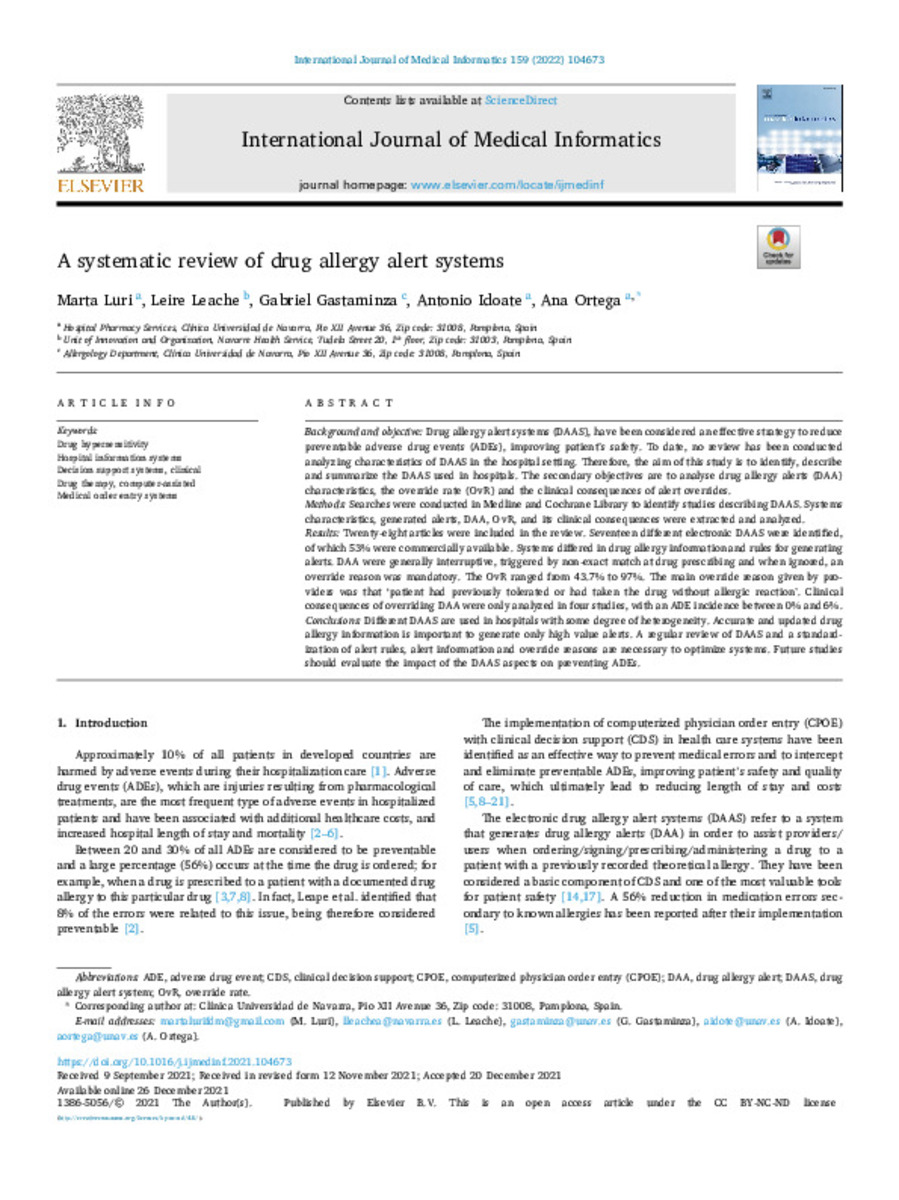Full metadata record
| DC Field | Value | Language |
|---|---|---|
| dc.creator | Luri-Fernández-de-Manzanos, M. (Marta) | - |
| dc.creator | Leache, L. (Leire) | - |
| dc.creator | Gastaminza, G. (Gabriel) | - |
| dc.creator | Idoate, A. (Antonio) | - |
| dc.creator | Ortega-Eslava, A. (Ana) | - |
| dc.date.accessioned | 2022-05-31T09:46:32Z | - |
| dc.date.available | 2022-05-31T09:46:32Z | - |
| dc.date.issued | 2022 | - |
| dc.identifier.citation | Luri-Fernández-de-Manzanos, M. (Marta); Leache, L. (Leire); Gastaminza, G. (Gabriel); et al. "A systematic review of drug allergy alert systems". International Journal of Medical Informatics. (159), 2022, 104673 | es_ES |
| dc.identifier.issn | 1386-5056 | - |
| dc.identifier.uri | https://hdl.handle.net/10171/63581 | - |
| dc.description.abstract | Background and objective: Drug allergy alert systems (DAAS), have been considered an effective strategy to reduce preventable adverse drug events (ADEs), improving patient’s safety. To date, no review has been conducted analyzing characteristics of DAAS in the hospital setting. Therefore, the aim of this study is to identify, describe and summarize the DAAS used in hospitals. The secondary objectives are to analyse drug allergy alerts (DAA) characteristics, the override rate (OvR) and the clinical consequences of alert overrides. Methods: Searches were conducted in Medline and Cochrane Library to identify studies describing DAAS. Systems characteristics, generated alerts, DAA, OvR, and its clinical consequences were extracted and analyzed. Results: Twenty-eight articles were included in the review. Seventeen different electronic DAAS were identified, of which 53% were commercially available. Systems differed in drug allergy information and rules for generating alerts. DAA were generally interruptive, triggered by non-exact match at drug prescribing and when ignored, an override reason was mandatory. The OvR ranged from 43.7% to 97%. The main override reason given by pro- viders was that ‘patient had previously tolerated or had taken the drug without allergic reaction’. Clinical consequences of overriding DAA were only analyzed in four studies, with an ADE incidence between 0% and 6%. Conclusions: Different DAAS are used in hospitals with some degree of heterogeneity. Accurate and updated drug allergy information is important to generate only high value alerts. A regular review of DAAS and a standard- ization of alert rules, alert information and override reasons are necessary to optimize systems. Future studies should evaluate the impact of the DAAS aspects on preventing ADEs. | es_ES |
| dc.language.iso | eng | es_ES |
| dc.publisher | Elsevier | es_ES |
| dc.rights | info:eu-repo/semantics/openAccess | es_ES |
| dc.subject | Drug hypersensitivity | es_ES |
| dc.subject | Hospital information systems | es_ES |
| dc.subject | Decision support systems, clinical | es_ES |
| dc.subject | Drug therapy, computer-assisted | es_ES |
| dc.subject | Medical order entry systems | es_ES |
| dc.title | A systematic review of drug allergy alert systems | es_ES |
| dc.type | info:eu-repo/semantics/article | es_ES |
| dc.description.note | This is an open access article under the CC BY-NC-ND license | es_ES |
| dc.identifier.doi | 10.1016/j.ijmedinf.2021.104673 | - |
| dadun.citation.number | 159 | es_ES |
| dadun.citation.publicationName | International Journal of Medical Informatics | es_ES |
| dadun.citation.startingPage | 104673 | es_ES |
Files in This Item:
Statistics and impact
Items in Dadun are protected by copyright, with all rights reserved, unless otherwise indicated.






